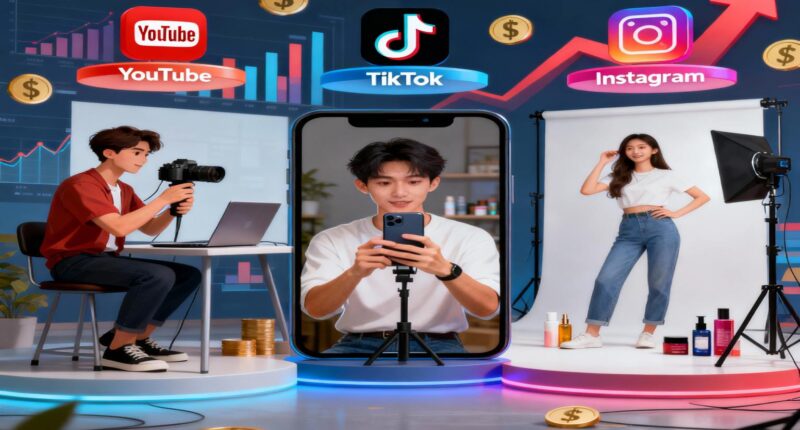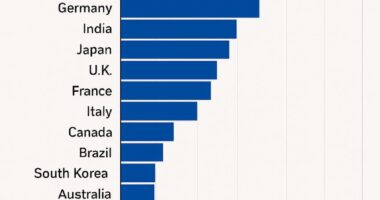Table of Contents
- Understanding the Monetization Ecosystem
- YouTube: The Long-Form Giant
- TikTok: Short-Form, High Impact
- Instagram: Visual Storytelling and Beyond
- Comparing Payment Structures
- Engagement Metrics and Their Impact on Earnings
- Finding the Right Platform for You
- Tips for Maximizing Your Earnings
- Conclusion: Choose Wisely for Your Future
Understanding the Monetization Ecosystem
Navigating the world of social media monetization can be daunting. With multiple platforms vying for creators’ attention, understanding how each one compensates its users is crucial. By unraveling the intricacies of YouTube, TikTok, and Instagram, you can make informed decisions about where to invest your time and creativity.
Each platform has its unique monetization methods—from ad revenue to creator funds and sponsorships. As a content creator or influencer, knowing these systems allows you to tailor your strategy to maximize your income potential.
YouTube: The Long-Form Giant
YouTube is a powerhouse when it comes to monetizing content, especially in the realm of long-form videos. Boasting billions of monthly active users, it offers creators several ways to earn:
- Ad Revenue: Through the YouTube Partner Program (YPP), creators can earn money from ads displayed on their videos. Generally, creators receive 55% of ad revenue, with the remaining 45% going to YouTube.
- Channel Memberships: This feature allows fans to pay a monthly fee for exclusive perks, including badges and access to member-only content.
- Super Chat and Super Stickers: Live-streaming features where fans can pay to have their messages highlighted, creating extra income during broadcasts.
- Merchandise Shelf: This allows creators to showcase and sell their merchandise directly on their channel.
While the initial criteria to join YPP may be challenging (over 1,000 subscribers and 4,000 watch hours within the past year), successful creators can see significant returns, sometimes cushioning their earnings with multiple streams from merchandise and sponsorships.
TikTok: Short-Form, High Impact
TikTok has rapidly emerged as a game-changer in social media monetization, especially for those focusing on short, creative videos. Its monetization strategies include:
- TikTok Creator Fund: This fund pays creators based on the view count of their videos. While some creators report earnings of a few cents per thousand views, successful viral videos can anchor substantial payouts.
- Brand Partnerships: Influencers on TikTok often collaborate with brands for sponsored content. Given TikTok’s engagement rates, brands are eager to invest in authentic, creative partnerships.
- Livestream Donations: Similar to Super Chat on YouTube, TikTok allows creators to receive virtual gifts from followers during live streams, which can be converted into cash.
- TikTok Shop: A relatively new feature, TikTok Shop enables creators to sell products directly within the app, paving the way for additional revenue sources.
While TikTok’s monetization might initially seem less lucrative compared to YouTube, the platform rewards creativity and virality; a single viral video can lead to substantial income and brand collaborations.
Instagram: Visual Storytelling and Beyond
Instagram has evolved significantly, transitioning from a photo-sharing app to a multifaceted platform for influencers. Its monetization avenues include:
- Sponsored Posts: Sponsored content remains king on Instagram. Influencers with a robust follower base can command hefty fees for promotional posts.
- Affiliate Marketing: By partnering with brands, influencers can use affiliate links to earn a percentage from sales generated through their posts.
- Instagram Reels and Ads: Similar to TikTok, Instagram Reels have opened up new avenues for monetization. Creators can earn through ad revenue that accompanies Reels, driving additional income streams.
- Paid Partnerships and Badges: Creators can engage with their followers through badges, allowing fans to support them during live videos.
- Shopping Features: For those in the lifestyle, fashion, or beauty niche, the ability to tag products in posts is invaluable. Influencers can directly drive sales through their curated content.
Instagram is unique in its strong emphasis on visual storytelling, leverageable through high-quality photography and videography. While it may require a more established following to monetize effectively, the rewards can be substantial.
Comparing Payment Structures
| Feature | YouTube | TikTok | Instagram | |—————————|——————————|—————————–|—————————–| | Ad Revenue | 55% to creator | Creator Fund, minimal payout| N/A | | Brand Partnerships | High potential based on audience size | Rapid growth opportunities | Strong, especially for large followers | | Livestream Earnings | Super Chat, Super Stickers | Gifts during live broadcasts | Badges in live streams | | Merchandise/Services Sales | Merch Shelf | TikTok Shop | Shopping Tagging | | Subscriber Fees | Memberships | N/A | N/A |
Engagement Metrics and Their Impact on Earnings
A creator’s income is heavily influenced by engagement metrics—such as likes, shares, comments, and watch time. Engagement often translates to loyalty; thus, understanding audience interaction can significantly impact your earnings.
- YouTube relies heavily on watch time and viewer retention. Higher retention rates mean more ad views, which boosts earnings. Videos with engaged audiences tend to rank higher in searches, making them more discoverable.
- TikTok promotes content through an intricate algorithm that favors engaging and original content. Viral videos can result in exponential follower growth, along with potential funding boosts from the Creator Fund.
- Instagram thrives on likes and saves; these interactions bolster visibility. Videos, posts, and Stories that garner conversations also drive higher traffic toward sponsored partnerships.
Optimizing your content to enhance engagement will improve its visibility across these platforms, ultimately leading to better monetization opportunities.
Finding the Right Platform for You
Determining which platform is the best fit depends on several factors, including:
- Content Type: Are you inclined toward creating long-form, detailed tutorials (YouTube), snackable creative content (TikTok), or beautifully curated visual stories (Instagram)?
- Audience Demographics: Understand your target audience. Different platforms attract varied age groups and interests.
- Monetization Goals: Your financial goals matter. Are you seeking high passive income through ad revenue or looking for quick cash from brand partnerships?
- Commitment: Each platform requires a distinct level of effort. Are you able to commit to regular uploads, is your content easily consumable, or do you thrive under high production values?
Finding the right platform involves aligning your content strategy with your strengths and audience expectations, ultimately leading to better monetization opportunities.
Tips for Maximizing Your Earnings
- Understand Your Niche: A clear niche helps tailor your content and attract the right audience. Engaged viewers are more likely to convert into loyal followers and buyers.
- Diversify Your Channels: While it’s important to focus on a primary platform, consider establishing a presence elsewhere. Cross-promoting content encourages audience crossover and builds multiple revenue streams.
- Leverage Analytics: Use the analytics tools offered by each platform to understand what works. This insight helps refine your approach.
- Engage with Your Audience: Building a community is vital. Respond to comments, host Q&As, and actively engage with your followers to foster loyalty.
- Stay Updated on Trends: Platforms evolve. By following trends and algorithm updates, you can adjust your strategies to stay relevant in the ever-changing landscape.
- Quality over Quantity: Especially on platforms like YouTube, producing high-quality content that delivers value tends to yield better engagement than merely focusing on volume.
- Network with Other Creators: Collaboration can expand your audience. Cross-promotions can introduce you to new followers who are interested in your content.
Conclusion: Choose Wisely for Your Future
Deciding between YouTube, TikTok, and Instagram ultimately depends on your content style, audience demographics, and monetization goals. By understanding the strengths each platform offers and how best to engage your followers, you can maximize your potential earnings.
Remember, the social media landscape is dynamic, and being adaptable is key. Invest time and energy into your craft, stay informed about the latest trends, and connect with your audience authentically. Your journey in the world of content creation can lead to fruitful opportunities across multiple platforms; the choice is yours!









